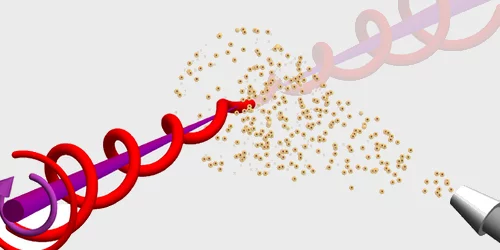Targeted manipulation of the magnetic moment of an atom
The spatiotemporal control of the electric component of a laser field opened the door to ultrafast science. It is known for very strong terahertz fields that the magnetic field component can drive magnetic dynamics. Spin dynamics can also be driven by the electric field of laser pulses in specific cases, for instance when spin-orbital coupling occurs.
Conventionally, charge currents are used to generate magnetic fields for magnetic excitations. However, these are difficult to control on the nanometer scale and suffer from joule losses. The possibility to tailor the wave front of laser pulses to form a light vortex, on the other hand, allows for a local magnetization build-up within femtoseconds, which is predicted to last even in the absence of the laser pulses.
The basic idea is to combine a Gaussian XUV beam and an IR light vortex that carries an orbital angular momentum. With these beams, it has been demonstrated previously that the OAM can be transferred to electrons. In contrast to the stimulated emission depletion effect, this arrangement can populate states that embody a nanoscale charge current loop, giving rise to an atomic-size magnetic moment.
Magnetic simulations meet experimental data
The effect described above was simulated by Jonas Wätzel and coworkers at the Martin-Luther-University Halle-Wittenberg in Germany. To prove the hypothesis, a team of international researchers from Germany, Switzerland, Slovenia and Italy conducted an experiment at the low density matter (LDM) beamline at the FERMI free electron laser in Trieste, Italy. The experts from the Optics groups at PSI took care of the generation of a clean optical vortex in the infrared laser pulse. The outcome of this experiment demonstrates how to generate nanoscale ferromagnetically aligned magnetic moments with a laser and shows how to control their characteristics. The agreement of the experimental results and the ab initio modeling confirms the femtosecond buildup of atomically confined directed current densities leading to the formation of nanometer scale magnetization that lasts for nanoseconds.
The results were published in the cover page article of Physics Review Letters 128, Vol 15 on April 13th, 2022.
Contacts
Benedikt Rösner
Laboratory for Non-Linear Optics
Paul Scherrer Institut, Forschungsstrasse 111, 5232 Villigen PSI, Switzerland
Telephone: +41 56 310 2454, email: benedikt.roesner@psi.ch [English, German]
Original Publication
Light-Induced Magnetization at the Nanoscale
Jonas Wätzel, Primož Rebernik Ribič, Marcello Coreno, Miltcho B. Danailov, Christian David, Alexander Demidovich, Michele Di Fraia, Luca Giannessi, Klavs Hansen, Špela Krušič, Michele Manfredda, Michael Meyer, Andrej Mihelič, Najmeh Mirian, Oksana Plekan, Barbara Ressel, Benedikt Rösner, Alberto Simoncig, Simone Spampinati, Matija Stupar, Matjaž Žitnik, Marco Zangrando, Carlo Callegari, Jamal Berakdar, and Giovanni De Ninno
Physical Review Letters 128, 2022, 157205
